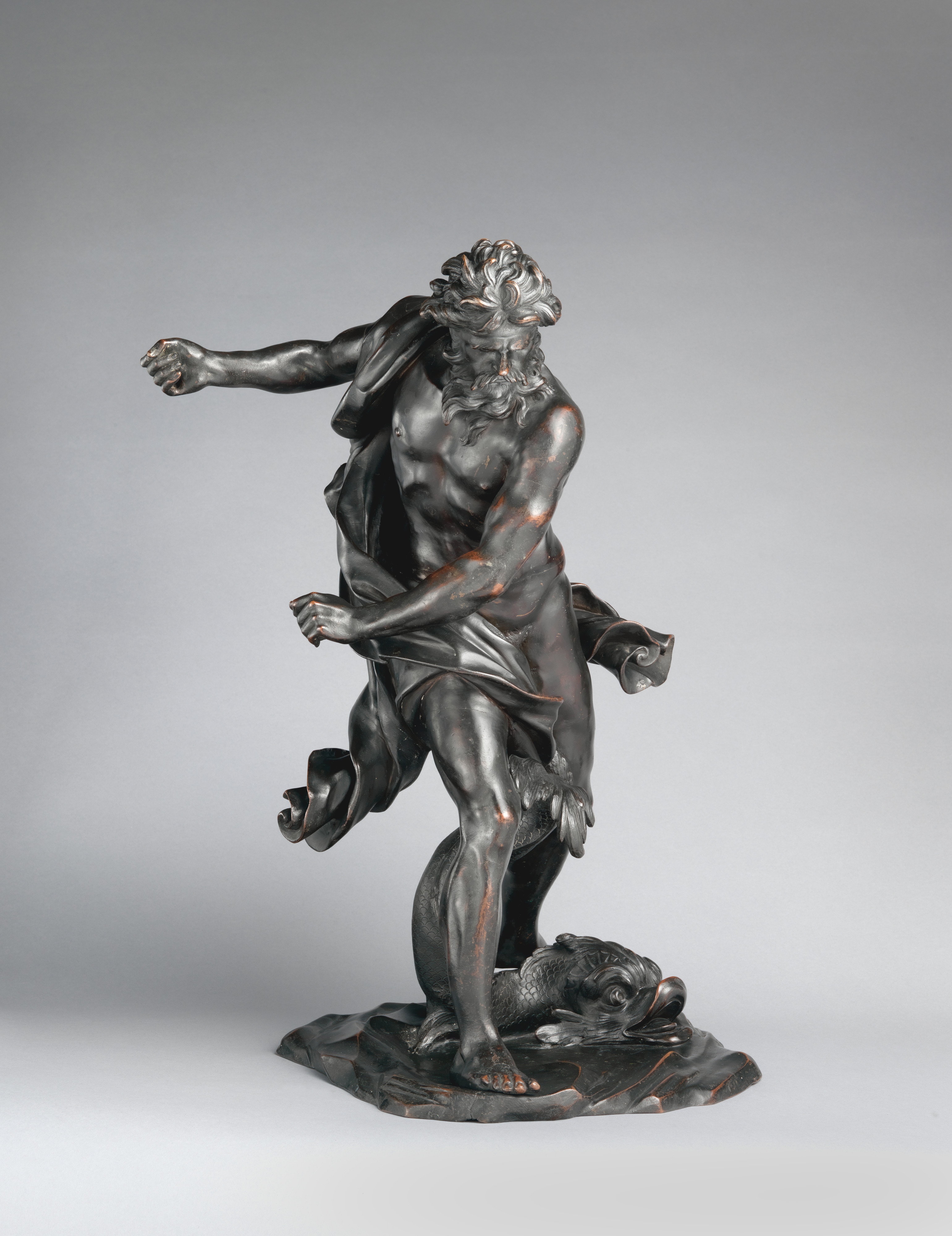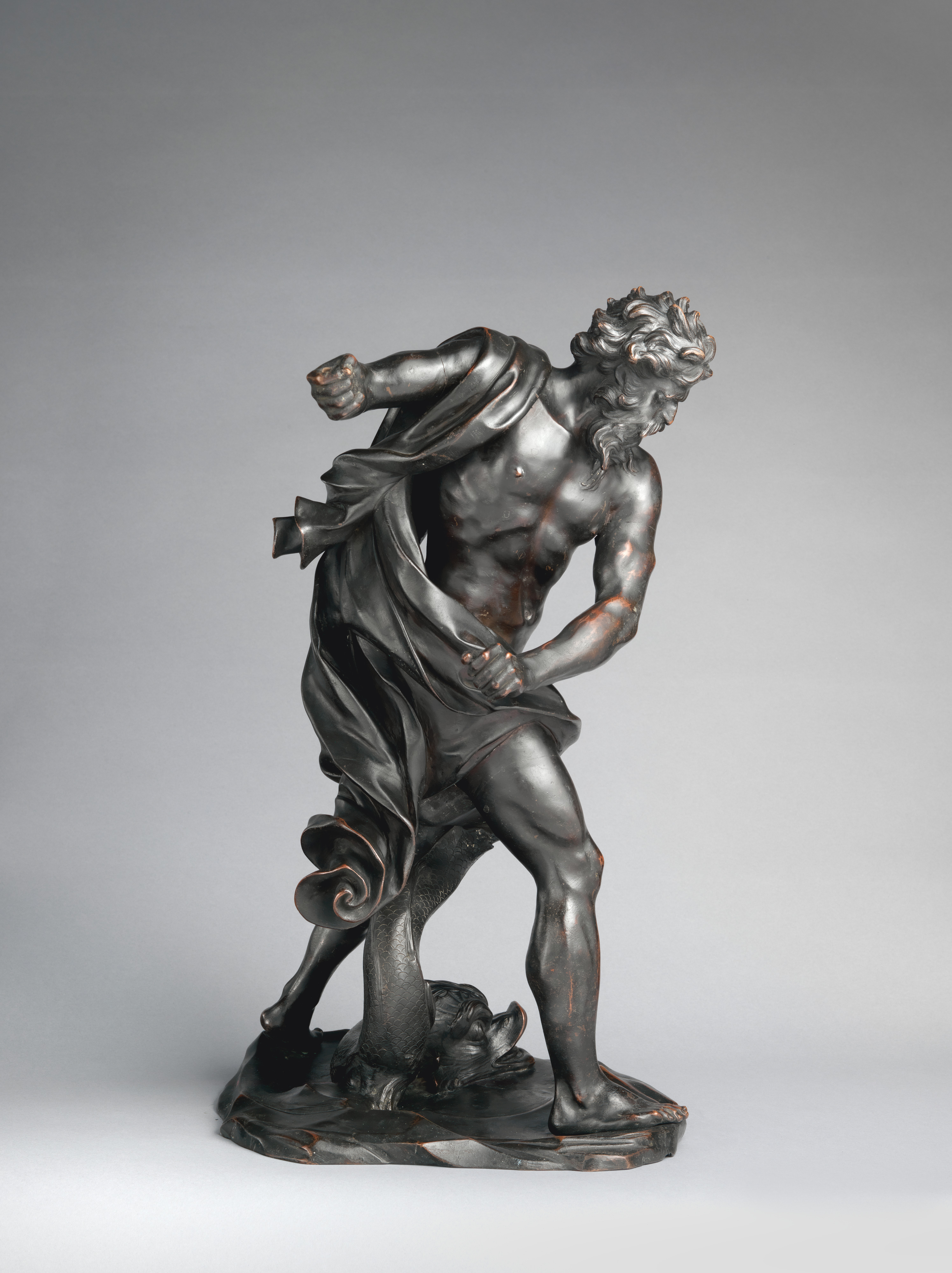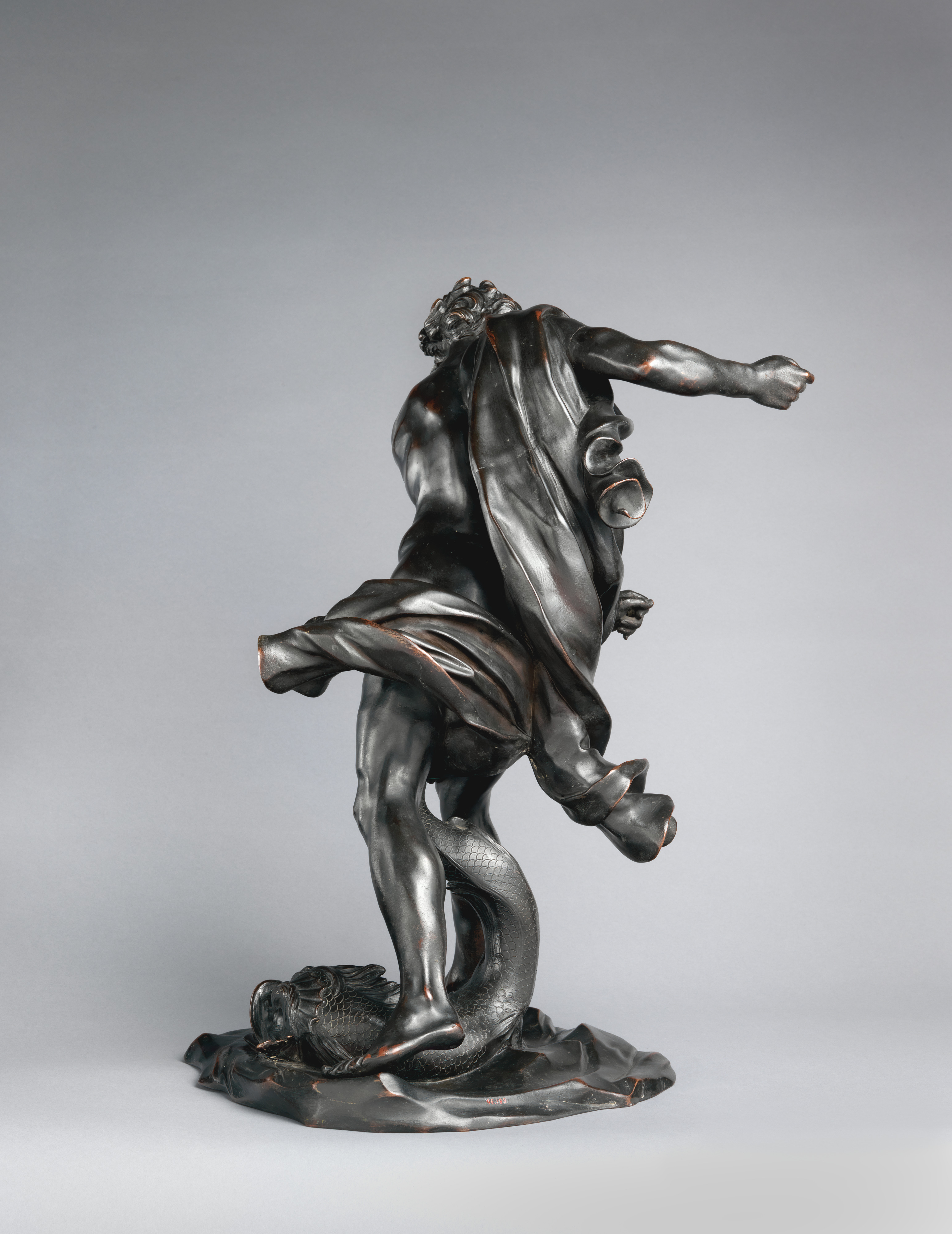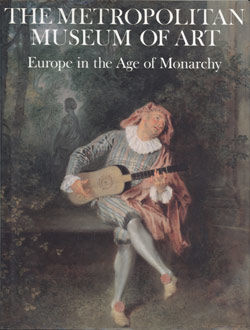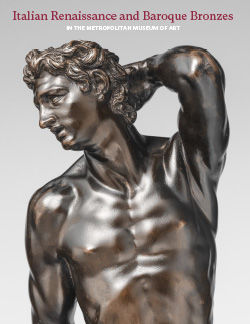Neptune with a dolphin
After a model by Gian Lorenzo Bernini Italian
Not on view
The group is a small-scale variant of Gian Lorenzo Bernini’s marble Neptune and Triton, carved between 1622 and 1623, which was once installed at the head of the fish pond at the Villa Montalto, Rome, and has been at the V&A since 1950.[1] The fountain enjoyed considerable fame and was reproduced in different mediums.[2] Bernini’s youthful groups were scaled down to bronze and silver versions during his lifetime, and often without his permission.[3] The Neptune with a Dolphin is, however, the only bronze reduction of one of his early marbles to show distinct compositional differences from the original: Neptune stands on a rocky islet instead of a shell, and a whirling dolphin, nestled between his legs, has replaced the Triton. The fluttering swirl of drapery behind Neptune’s proper right thigh is positioned so that more of it is visible even from the front.
Our Neptune with a Dolphin is one of four known casts. The others are in the Corsini collection, on loan to the Galleria Borghese, Rome; the V&A; and the Getty.[4] They are all quite close in size, and were probably cast from different stages of the same model. When compared, the four statuettes reveal several small variations, probably introduced in the wax intermodels, as well as notable differences in facture.[5] Our version is missing the trident.[6] In the Getty and Borghese groups, the dolphin’s tail touches Neptune’s proper left leg; in ours, an additional fin has been added to the fish tail to create a similar effect, while in the V&A’s the tail does not make contact with the god’s body. The treatment around the dolphin’s eyes is more stylized in our group than in the Borghese and Getty statuettes. Scholars agree the version in Los Angeles is the finest cast.
Bernini’s authorship of a small-scale model to be cast in bronze has long been disputed. In 1998, discussing the Borghese version, Sebastian Schütze rightly dismissed the notion, suggesting instead a Florentine artist close to Giovanni Francesco Susini, in view of the Corsini provenance and the highly polished surface.[7] Peter Fusco advocated Bernini’s own hand, but Philippe Malgouyres has more convincingly argued that the bronze reductions may not even have been produced in Bernini’s circle.[8] The composition seems a curious assemblage of stylistic elements from his works: the Neptune is a copy of the figure for the Villa Montalto; the dolphin belongs to the same breed as the marine mammals designed by Bernini after the 1650s.
This discrepant combination of early and late elements may be explained through a comparison with another Neptune fountain in Portugal that has been studied only recently.[9] Dom Luís Menses, third conde de Ericeira, a prominent political and cultural figure in late seventeenth-century Portugal, commissioned this work from Bernini through the Portuguese ambassador in Rome, Dom Luís de Sousa, archbishop and primate of Braga. In a letter of 1677 from the archbishop to his brother, he recounts that Bernini supplied a modello of the Neptune. After studying different hydraulic possibilities with Ercole Ferrata, they agreed that dolphins would be placed between Neptune’s feet, and the group would be carved by Ferrata. The fountain was shipped to Portugal in 1682 and placed in the gardens of the Anunciada Palace in Lisbon, where the Neptune figure was soon praised as a work by Bernini, who in all likelihood had entrusted the whole ensemble to Ferrata after setting the basic design. Ferrata’s estate inventory refers to models of Neptune, in both clay and wax. It is tempting to place the model for the bronze reductions of Neptune with a Dolphin in the context of the industrious workshop run by Ferrata in Rome, a model later reused to produce commercial bronzes destined for collectors in the eighteenth century.
-PD’A
Footnotes
(For key to shortened references see bibliography in Allen, Italian Renaissance and Baroque Bronzes in The Metropolitan Museum of Art. NY: The Metropolitan Museum of Art, 2022.)
1. V&A, A.18:1-1950. The fountain was commissioned by Cardinal Alessandro Peretti, who played an important role in Bernini’s early career. The Neptune and Triton stayed in the Villa Montalto until 1786, when it was sold to the British art dealer Thomas Jenkins, then acquired by Sir Joshua Reynolds and shipped to England. Its history has been reconstructed in detail in Maclagan 1922 and Wittkower 1952; for further references, see Pope-Hennessy 1964a, vol. 2, pp. 596–600, no. 636; Wittkower 1981, pp. 28–29, 177–78, no. 9; Sebastian Schütze in Coliva and Schütze 1998, pp. 170–79, cat. 15.
2. Several seventeenth- and eighteenth-century engravings show the group in its original location. The V&A has a reduced copy in wood (Pope-Hennessy 1964a, vol. 2, p. 609; Weston-Lewis 1998, pp. 89–90, cat. 41), and a marble reduction is mentioned in the collection of Antonio Muñoz, together with a lead variant (Faldi 1954, p. 43; see also Pope-Hennessy 1964a, vol. 2, p. 600). A terracotta fragment of Neptune’s torso, now in the Hermitage, comes from the Farsetti collection; a full-size plaster copy of the Neptune and Triton was in the same collection, now in the Academy of Fine Arts, Saint Petersburg: Androsov 1991, p. 52, cat. 13; Wardropper 1998, p. 6, cat. 10.
3. Malgouyres 2013, p. 74.
4. See, respectively, Schütze in Coliva and Schütze 1998, pp. 170–79, cat. 15; Pope-Hennessy 1964a, vol. 2, p. 600; Peter Fusco in Fogelman et al. 2002, pp. 170–76, no. 22. Two bronze casts of the marble Neptune were auctioned in London in the eighteenth century: the first, in the collection of the British sculptor Bird, was sold in April 1731 (Esdaile 1938, p. 139). The second, “a capital bronze of the Neptune, in the villa Negroni in Rome,” was auctioned at Jean Bertels, London, May 26–28, 1783, lot. 81. Another bronze Neptune with a Dolphin was in the sale of the Palazzo San Donato, Florence, March 15, 1880, lot 307; looking at the illustration, this could be the version now at the V&A.
5. Our version was cast in ten sections joined with Roman-type joins, with one part telescoping into another then fixed with pins, suggesting it was part of a larger edition of sectional casts, possibly including the Corsini Neptune. There is minimal chasing and most details appear to be in the wax, with broader surfaces smoothed by filing. The core is plaster and core supports are randomly placed wires that were replaced with screw plugs. R. Stone/TR, April 21, 2010.
6. The trident of the Borghese version is a modern replacement after the original was stolen in 1947 (Faldi 1954, p. 43).
7. Coliva and Schütze 1998, p. 176.
8. Fogelman et al. 2002, p. 172; Malgouyres 2013, p. 74.
9. Delaforce et al. 1998, to which the following discussion in indebted (pp. 807–8).
Due to rights restrictions, this image cannot be enlarged, viewed at full screen, or downloaded.
This artwork is meant to be viewed from right to left. Scroll left to view more.


